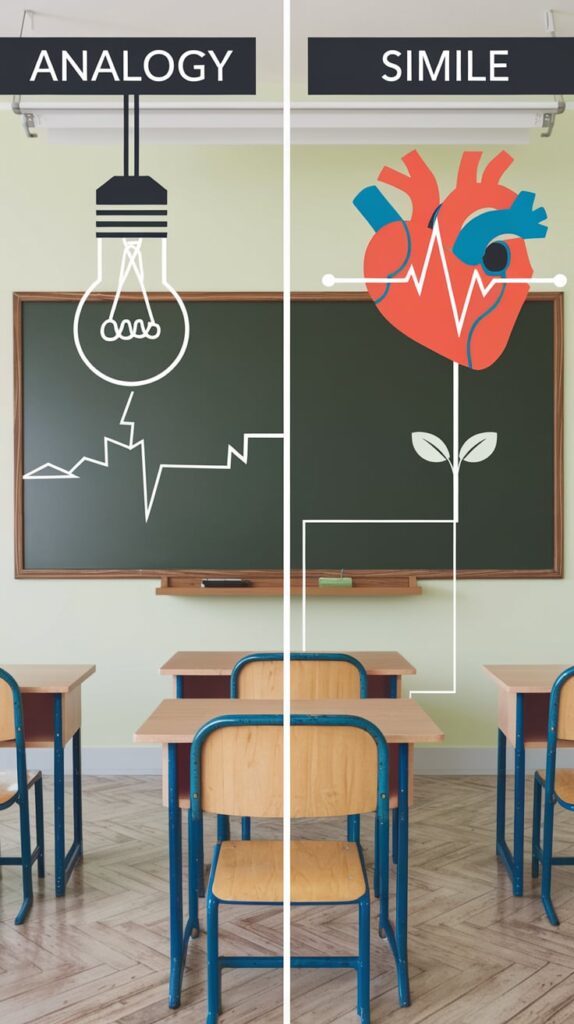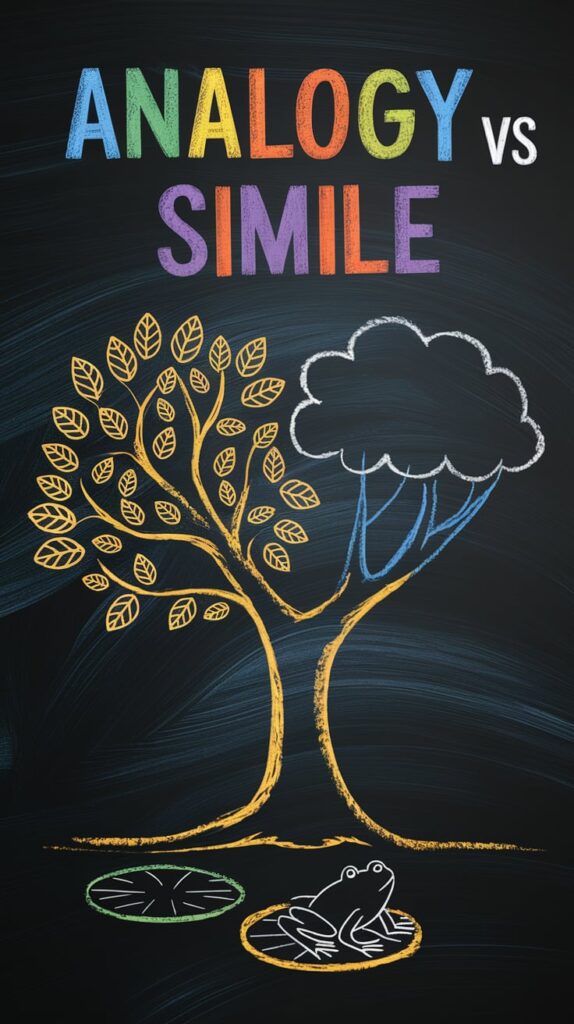Introduction
Language is a powerful tool that allows us to communicate complex ideas, evoke emotions, and paint vivid pictures in the minds of our readers. Among the various techniques available, analogy vs simile are two of the most frequently used forms of comparison in writing and conversation.
Understanding the distinction between these two tools can significantly enhance your communication skills and make your writing more engaging and relatable.
In this article, we will explore the nuances of analogy vs simile, providing clear definitions, examples, origins, and practical applications. By the end, you’ll have a deeper understanding of when to use each tool effectively, making you a more versatile communicator.
read more : Cancellation or Cancelation: Differences – Grammar Beacon
What’s an Analogy?
An analogy is a literary device that compares two different things to highlight a similarity between them. This comparison often clarifies an idea or concept by relating it to something more familiar or easier to understand.
Analogies serve as powerful explanatory tools, particularly when dealing with complex or abstract ideas.

Examples of Analogy
To illustrate the use of analogies, consider these examples:
Time is a thief: This analogy suggests that time stealthily takes away moments from our lives, similar to how a thief would take possessions.
Life is a journey: This widely used analogy implies that life involves many paths, choices, and experiences, much like traveling from one destination to another.
Both examples help convey deeper meanings by relating unfamiliar concepts to familiar experiences.
read more : Sit vs Set: How to Correctly Use Them – Grammar Beacon
Origins of Analogy
The term analogy comes from the Greek word “analogia,” which means “proportion” or “relation.” The use of analogies can be traced back to ancient texts and literature, where writers used them to explain philosophical concepts or moral lessons.
The ability to draw parallels between different ideas has made analogies a timeless tool in literature, education, and everyday conversation.
What’s a Simile?
A simile is a figure of speech that makes a direct comparison between two different things using the words “like” or “as.” Similes are effective for creating vivid imagery and helping readers visualize concepts or emotions.
They often serve to enhance the emotional impact of writing by relating one object or idea to another in a relatable way.

Examples of Simile
Here are some classic examples of similes:
He was as brave as a lion: This simile compares a person’s bravery to that of a lion, effectively conveying a sense of courage.
Her voice was like music to my ears: This simile emphasizes the pleasantness of her voice by comparing it to music, evoking a sensory experience.
These comparisons are straightforward, yet they can leave a lasting impression on the reader’s mind.
read more : Artist vs Artisan: Understanding the Key Differences – Grammar Beacon
Origins of Simile
The word simile originates from the Latin term “simile,” which translates to “like” or “similar.” This form of comparison has been prevalent across various cultures and languages for centuries.
Many classic literary works, including poetry and prose, employ similes to enhance their expressiveness and emotional depth. By using similes, writers can create connections that resonate with readers on a personal level.
Analogy vs Simile: The Differences
Though both analogy vs simile involve comparisons, they differ in structure, purpose, and complexity. Understanding these differences is crucial for effective communication.

Nature of Comparison
Analogy: An analogy often draws a broader and deeper comparison, explaining one idea through another. It may involve multiple aspects or points of similarity, allowing for a more detailed exploration of concepts.
Simile: A simile provides a direct comparison between two specific things, focusing on a single quality or feature. It typically employs “like” or “as” and is more straightforward in its approach.
Purpose
Analogy: The primary goal of an analogy is to clarify or explain a concept by relating it to something more familiar. It is often used in educational contexts to help readers grasp complex ideas or processes.
Simile: The main function of a simile is to create vivid imagery or evoke emotions. It is commonly found in literature, poetry, and everyday speech to enhance descriptions and engage the audience.
Length and Complexity
Analogy: Analogies can be longer and more elaborate, sometimes comprising entire sentences or paragraphs. They often explore various facets of the comparison to enrich understanding.
Simile: Similes are typically concise, often just a few words long, making them easy to recognize and understand quickly.
Choosing the Right Tool: When to Use Analogy or Simile
When faced with the decision to use an analogy or a simile, consider the context and your communication goals. Here are some guidelines to help you choose the right tool:
Use Analogy When:
Explaining Complex Concepts: If you’re trying to clarify a difficult or abstract idea, analogies can break it down into relatable terms. For instance, comparing the structure of an atom to a solar system can help illustrate its components.
Creating Connections: If you want to link two seemingly unrelated ideas to illuminate a topic, an analogy can effectively bridge that gap. For example, saying that “a successful business is like a well-tuned orchestra” suggests that both require coordination and harmony.
Use Simile When:
Creating Vivid Imagery: When your goal is to paint a picture in the reader’s mind, similes can add sensory detail. For instance, “The moon was like a silver coin in the night sky” evokes a clear and beautiful image.
Adding Emotion: If you want to evoke specific feelings or set a mood, a simile can be a powerful tool. For example, “Her laughter was like a bubbling brook” conveys joy and lightness.
Scenarios Illustrating Analogy vs Simile
To clarify the differences between analogy and simile, let’s consider practical scenarios:
Scenario 1: Explaining Scientific Concepts
Analogy: “The process of photosynthesis is like baking a cake; just as you need the right ingredients and steps to create a delicious dessert, plants need sunlight, carbon dioxide, and water to produce food.”
Simile: “The leaves fluttered in the wind like dancers on a stage.”
In this scenario, the analogy simplifies the complex process of photosynthesis by comparing it to baking, while the simile vividly describes the movement of leaves.

Scenario 2: Describing Emotions
Analogy: “Grief is like an ocean, vast and unpredictable; sometimes it’s calm, but it can also surge with overwhelming waves that threaten to drown you.”
Simile: “Her heart sank like a stone.”
Here, the analogy offers a profound comparison that explores the nature of grief, while the simile succinctly conveys a sudden feeling of disappointment.
Scenario 3: Everyday Conversations
Analogy: “Raising a child is like tending to a garden; it requires patience, love, and consistent effort to help them grow.”
Simile: “He was as sly as a fox.”
In this context, the analogy provides insight into the complexities of parenting, while the simile delivers a quick and memorable comparison.
Using Analogy and Simile in Writing
Incorporating analogy vs simile into your writing can enhance clarity and engagement. Here are some tips for effectively using these tools:
Understanding Your Audience
When choosing between analogy and simile, consider your audience. If you’re writing for a general audience, simpler similes may be more effective. In contrast, analogies might be better suited for academic or technical writing, where deeper explanations are required.
Balancing Both Tools
Using both analogies and similes can create a rich tapestry of language. For instance, in a descriptive passage, you might start with a simile for immediate impact and follow with an analogy for deeper understanding.
Avoiding Clichés
While both analogies and similes can be powerful, avoid overused phrases or clichés. For example, saying “as brave as a lion” might not resonate as strongly because it has been used so often.
Instead, strive for originality in your comparisons to make your writing stand out.
Practicing with Examples
To hone your skills in using analogies and similes, practice crafting your own examples. Take a complex idea and write an analogy that explains it clearly.
Then, create similes that evoke strong imagery related to the same concept. This exercise will help you become more comfortable with both forms of comparison.

The Importance of Analogies and Similes in Communication
Understanding analogy vs simile is crucial not just for writing, but also for effective communication in various contexts. Here’s why these tools are important:
Clarity and Understanding
Both analogies and similes enhance clarity by relating unfamiliar concepts to familiar ones. This can be particularly useful in educational settings, where explaining complex theories requires relatable examples.
Emotional Resonance
Similes, in particular, evoke emotions by painting vivid pictures in the reader’s mind. This emotional connection can enhance storytelling and make the audience more invested in the narrative.
Creative Expression
Analogies and similes provide writers with the means to express themselves creatively. By drawing unique comparisons, authors can convey complex ideas in engaging ways that resonate with their audience.
Cultural Relevance
Both tools are often rooted in cultural references, making them relatable to specific audiences. Understanding cultural nuances can enhance the effectiveness of analogies and similes, allowing for more impactful communication.
Conclusion
In conclusion, grasping the distinctions between analogy vs simile is essential for effective communication and writing. While both serve the purpose of making comparisons, they do so in different ways that cater to various needs in writing.
By mastering the use of analogies and similes, you can enhance your ability to convey complex ideas, create vivid imagery, and connect with your audience on a
deeper level. Whether you are crafting a narrative, explaining a scientific concept, or engaging in everyday conversations, knowing when and how to use these tools will enrich your communication and make your writing more impactful.
So, the next time you sit down to write or speak, remember the power of analogies and similes. With practice, you can skillfully navigate the landscape of analogy vs simile, elevating your language and ensuring that your ideas resonate with clarity and creativity.
Here’s a summary table that captures the key points discussed in the article about Analogy vs Simile:
| Aspect | Analogy | Simile |
|---|---|---|
| Definition | A comparison between two different things to explain a concept | A direct comparison between two things using “like” or “as” |
| Purpose | Clarifies or explains complex ideas | Creates vivid imagery and evokes emotions |
| Structure | Often longer, can include multiple points of comparison | Typically concise, focusing on a single quality |
| Use in Communication | Effective for teaching and explaining | Enhances emotional impact and imagery |
| Examples | “Life is a journey.” | “He was as brave as a lion.” |
| Origin | Derived from Greek “analogia,” meaning relation | From Latin “simile,” meaning like or similar |
| Common Uses | Academic writing, technical explanations | Poetry, literature, everyday conversation |
| Choosing the Right Tool | Use for complex concepts or to draw connections | Use for vivid imagery or to express emotions |
This table provides a quick reference to help distinguish between analogies and similes, summarizing their definitions, purposes, structures, examples, and more.

Steve Rogars is an experienced blogger and language enthusiast at Grammar Beacon. With a passion for clear communication and a keen eye for detail, he shares insights on grammar, writing tips, and language trends. Steve’s engaging style makes learning enjoyable, helping readers enhance their writing skills. When he’s not crafting posts, he enjoys reading, exploring new cultures, and inspiring others to appreciate the beauty of language.







